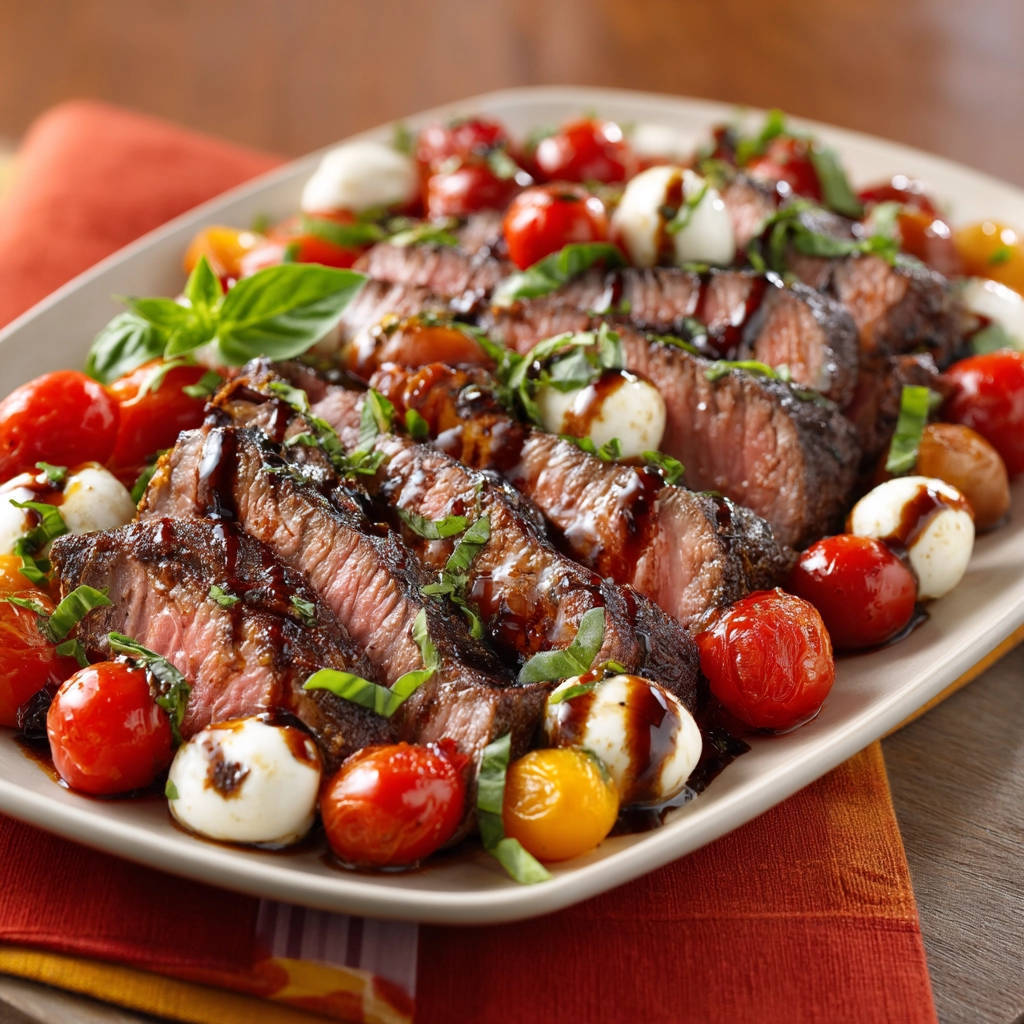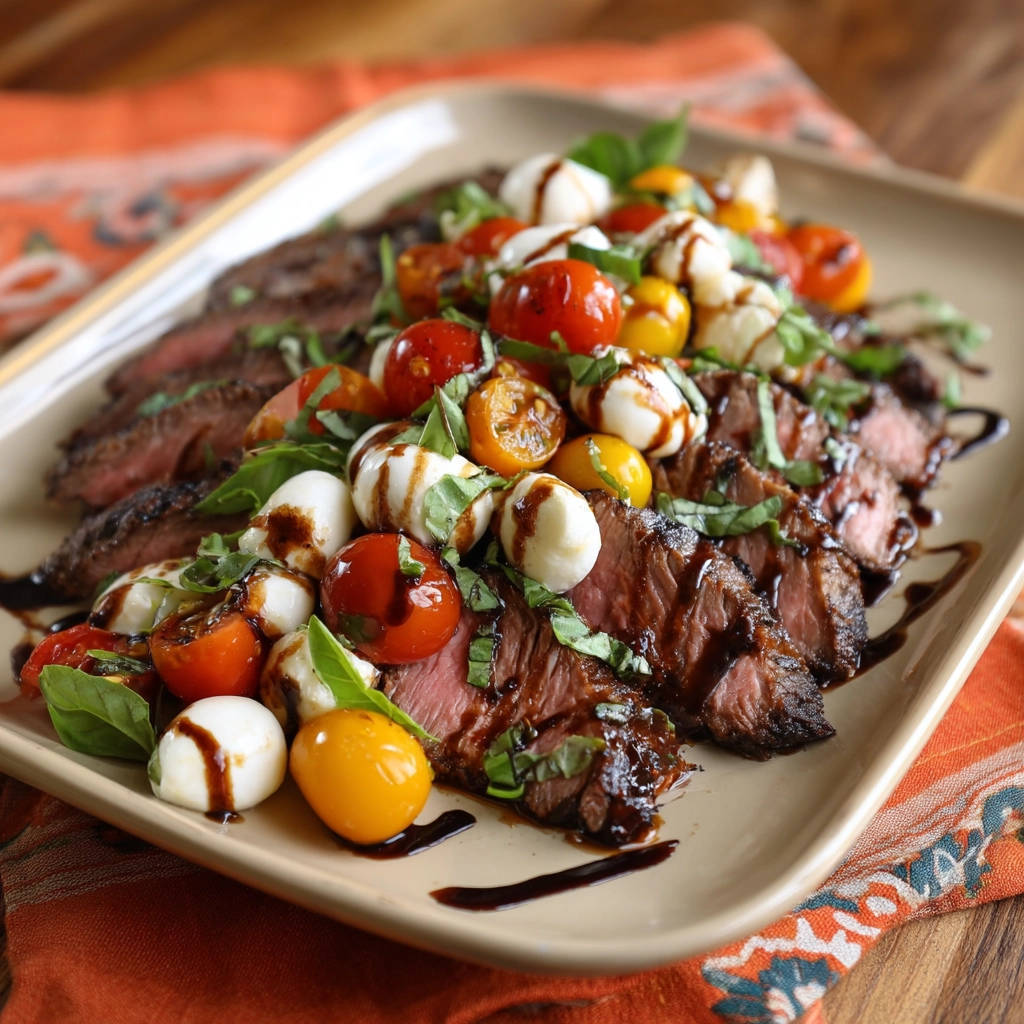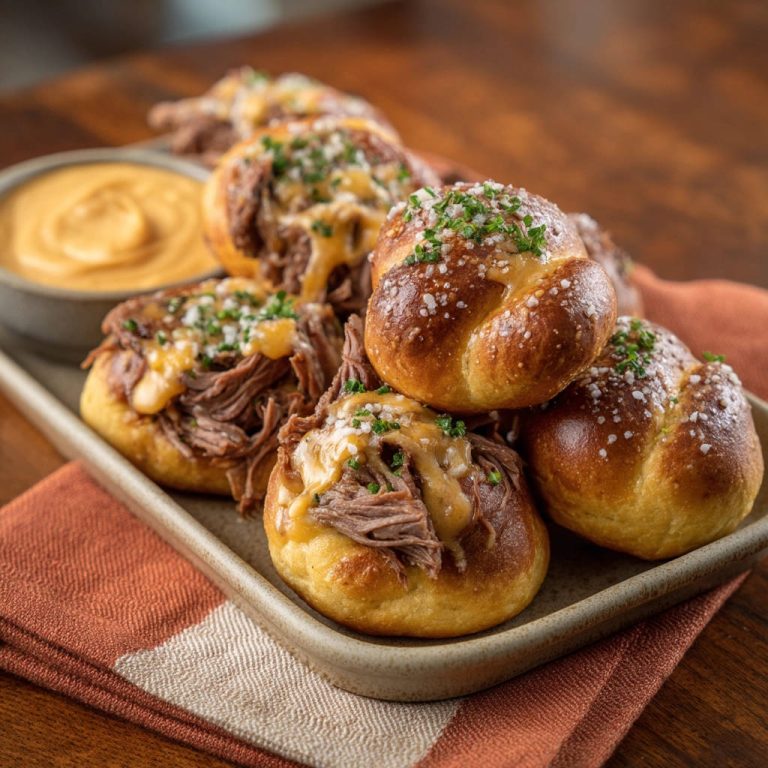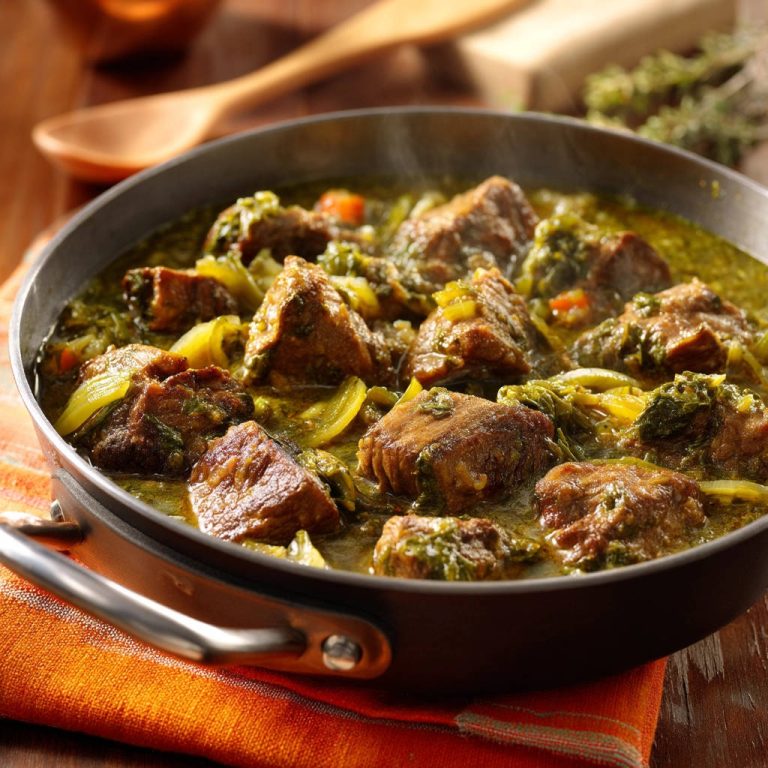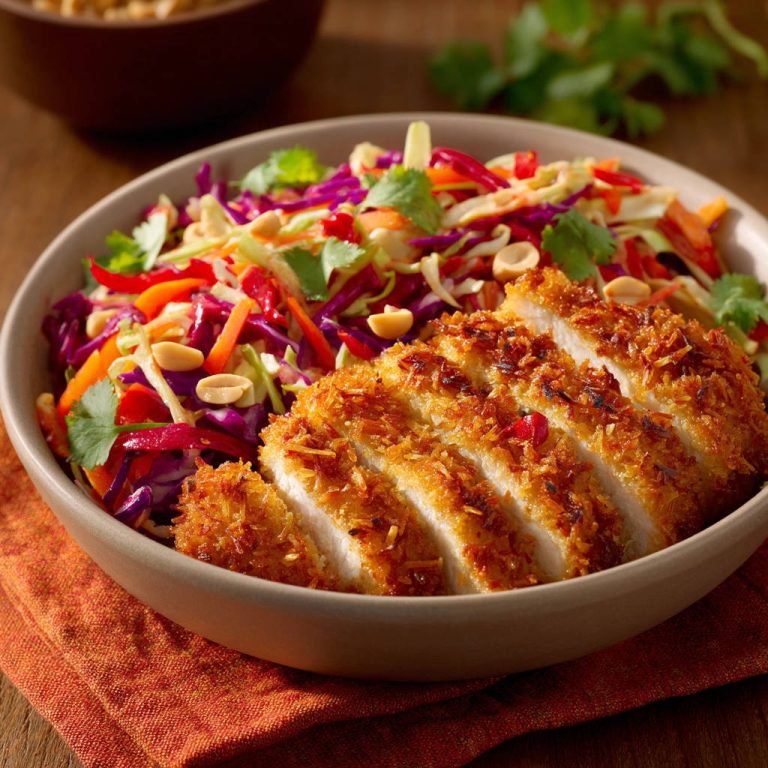Getting that perfect steak at home used to feel utterly impossible for me. It was a source of constant frustration – always undercooked in the middle, tragically overcooked on the edges, or just frustratingly uneven. I’d try different techniques, different pans, different levels of patience, but nothing seemed to consistently deliver that restaurant-quality result.
But then, I discovered a simple yet incredibly effective method. It’s not complicated, doesn’t require fancy equipment (though a good pan helps!), and focuses on a few key principles that make all the difference. Using this technique transformed my home steak cooking from a gamble into a guaranteed success. Now, every steak comes out beautifully cooked, wonderfully juicy, and bursting with flavor. And when you pair that perfectly seared steak with the fresh, vibrant flavors of a classic Caprese salad? You’ve got dinner perfection on your hands.
This Pan-Seared Steak Caprese recipe is proof that you don’t need to be a gourmet chef to create something truly special at home. It’s quick enough for a weeknight, yet elegant enough for company. Get ready to crack the code and enjoy flawless steak topped with a bright, summery medley.
Why You’ll Absolutely Love This Pan-Seared Steak Caprese
There are so many reasons why this recipe has become a staple in my kitchen and why I think you’ll fall in love with it too. It’s more than just a meal; it’s a simple pleasure that feels incredibly rewarding to make.
First off, it’s surprisingly fast. From start to finish, you can have this impressive dish on the table in about 30 minutes. Perfect for those busy evenings when you crave something satisfying but don’t have hours to spend in the kitchen.
Secondly, the technique guarantees a juicy, perfectly cooked steak. No more guessing games or disappointing cuts. By focusing on the right pan, the right heat, and one essential tool, you’ll achieve your desired level of doneness every single time. You can even master achieving a delicious crust, just like a professional chef!
Finally, the Caprese topping is the ultimate flavor explosion. The sweetness of the tomatoes, the creamy freshness of the mozzarella, the aromatic basil, and the tangy-sweet balsamic glaze come together to create a bright, refreshing counterpoint to the rich, savory steak. It’s a harmonious marriage of textures and tastes that feels both indulgent and wonderfully light.
Gathering Your Ingredients for Perfect Pan-Seared Steak Caprese
The beauty of this dish lies in its simplicity and the quality of its components. While the technique for the steak is key, using fresh, flavorful ingredients for the Caprese element elevates the entire experience. Here’s a look at what you’ll need and why each part plays a crucial role in creating this delightful Pan-Seared Steak Caprese.
We start with the star: the steak. Choosing the right cut makes a difference for pan-searing. You want something tender and flavorful, ideally about 1 inch thick for easier temperature control. Cuts like sirloin, strip, or ribeye are excellent choices. Sirloin offers great flavor without being overly fatty, strip is a classic for its balance, and ribeye provides that rich, buttery texture. Aim for 1 to 1.5 pounds, which generously serves four people.
Seasoning is simple but essential. Good quality salt and freshly ground black pepper are all you need to enhance the natural taste of the beef. Don’t be shy with the seasoning; a generous hand ensures a flavorful crust.
For the pan-searing itself, you’ll need olive oil. A couple of tablespoons are used in the pan to help create that beautiful golden-brown crust on the steak. You’ll also want a little extra for drizzling over the finished dish, adding richness and shine.
Now, onto the vibrant Caprese components. We use cherry or grape tomatoes, about 2 cups worth. These small varieties are perfect because they’re naturally sweet and pop in your mouth. Their size also makes them easy to arrange with the sliced steak and mozzarella. If you use slightly larger ones, you can simply halve them.
The cheese component comes from small mozzarella balls, also known as perlini (very small) or bocconcini (slightly larger). You’ll need about 8 ounces. These provide a delightful creamy texture and mild flavor that complements the other ingredients beautifully. Make sure to drain them well if they come packed in liquid to avoid excess moisture on your serving platter.
Fresh basil leaves are non-negotiable! This aromatic herb is the soul of Caprese. You’ll need about 1/2 cup of fresh leaves, torn or chopped just before using. The bright, slightly peppery notes of fresh basil are essential to the dish’s character.
Finally, a drizzle of balsamic glaze brings everything together. This sweet and tangy reduction adds a layer of complex flavor and visual appeal. You can buy pre-made balsamic glaze or easily make your own by simmering balsamic vinegar until it reduces and thickens.
- 1 to 1.5 pounds steak (such as sirloin, strip, or ribeye), about 1 inch thick
- 2 tablespoons olive oil, plus more for drizzling
- Salt
- Black pepper
- 2 cups cherry or grape tomatoes
- 8 ounces small mozzarella balls (perlini or bocconcini), drained
- 1/2 cup fresh basil leaves, torn or chopped
- Balsamic glaze, for drizzling
Crafting Your Delicious Pan-Seared Steak Caprese: Step-by-Step Mastery
Let’s walk through the process of making this incredible dish. Each step is simple, but paying attention to the details is what truly makes the difference between an okay steak and a spectacular one. Remember, the goal is a beautiful sear on the outside and a perfectly cooked interior. Ready? Let’s cook!
-
Prepare the Steak for Searing: This is arguably the most critical first step for achieving a good crust. Take your steak and pat it absolutely dry on all sides using paper towels. Moisture on the surface of the steak will steam it instead of searing it, preventing that lovely brown crust from forming. Next, season it generously with salt and black pepper. Don’t be shy! The salt helps develop flavor and draw out some moisture initially, which aids in searing. After seasoning, let the steak sit at room temperature for about 30 minutes. This allows the salt to penetrate the meat and, importantly, brings the internal temperature up slightly, promoting more even cooking from edge to center. It takes the chill off so the center isn’t ice-cold when the outside is cooked.
-
Heat Your Skillet to Perfection: For pan-searing, a heavy skillet is your best friend – cast iron is ideal because it holds heat incredibly well and distributes it evenly. Place your skillet over high heat and let it get very hot. How hot? You should see a faint wisp of smoke, and a drop of water should sizzle and evaporate almost instantly. This high heat is essential for creating that quick, beautiful sear. Once the pan is screaming hot, carefully add the 2 tablespoons of olive oil. Swirl it around to coat the bottom evenly.
-
The Sear is Key: Now, gently and carefully place the seasoned, room-temperature steak into the hot skillet. Be cautious as it will likely sizzle and spatter. Resist the urge to move it! Let it sear undisturbed for 3-4 minutes per side for medium-rare doneness. This time is a guideline; the actual time needed will depend on your stove, pan, and the steak’s exact thickness and temperature. The most reliable way to ensure perfect results is to use an instant-read thermometer. After searing on the first side and flipping, insert the thermometer horizontally into the thickest part of the steak, making sure you’re not touching any fat or bone, which can give a false reading. You’re aiming for an internal temperature of 130-135°F (54-57°C) for a lovely medium-rare, or 135-140°F (57-60°C) for medium. Adjust the searing time based on your thermometer reading and desired doneness.
-
Rest, Rest, Rest!: As soon as your steak reaches its target internal temperature, remove it immediately from the hot skillet and place it on a clean cutting board. This next step is absolutely critical – do not skip it! Let the steak rest for at least 5-10 minutes before you even think about slicing it. As the steak cooks, the juices are pushed towards the center by the heat. Resting allows these juices to redistribute back throughout the meat. If you cut it too soon, all that delicious juiciness will run out onto your cutting board instead of staying in the steak, leaving you with a dry result. The steak will continue to cook slightly during this rest period (carryover cooking), which is factored into the target temperatures mentioned above.
-
Assemble the Caprese Elements: While your beautiful steak is resting, it’s the perfect time to prepare the fresh components for the Caprese topping. Take your cherry or grape tomatoes. If they are on the larger side, you can quickly halve them for easier eating and presentation. Ensure your small mozzarella balls (perlini or bocconcini) are well-drained if they were packed in liquid. Excess liquid can make the platter watery. Gather your fresh basil leaves and give them a rough tear or chop. The goal is fresh pieces of basil, not a finely minced herb.
-
Slice the Steak Against the Grain: Once the steak has had its full rest, it’s time to slice it. Always slice steak against the grain. You’ll notice lines running through the meat; slicing perpendicular to these lines shortens the muscle fibers, making each bite much more tender and easy to chew. Aim for slices about 1/2 inch thick – substantial enough to show off the beautiful interior cook but thin enough to be easily enjoyed.
-
Arrange for Beauty: Now for the presentation! On a serving platter or individual plates, artfully arrange the sliced steak, the sweet cherry tomatoes, and the creamy mozzarella balls. Don’t just pile them up; think about creating a visually appealing display. Scatter the torn or chopped fresh basil leaves generously over all the components. The vibrant green really makes the dish pop.
-
Finish with Glaze: The final touch is a generous drizzle of balsamic glaze over the entire platter. This adds that perfect balance of sweetness and acidity, enhancing the flavors of the steak, tomatoes, and mozzarella, and giving the dish a beautiful, glossy finish. Serve immediately and prepare for compliments!
Tips for Perfect Pan-Seared Steak Caprese Every Time
Achieving that restaurant-quality pan-seared steak with Caprese is simple once you know the tricks. Here are a few extra tips to ensure your dish is consistently amazing:
- Don’t Rush the Room Temperature Step: Allowing the steak to sit out for 30 minutes really does make a difference in how evenly it cooks. A cold center takes much longer to reach temperature, meaning the outer edges can overcook by the time the middle is done.
- Use a Hot, Heavy Pan: As mentioned, a cast iron or other heavy-bottomed skillet is best for searing. It retains and distributes heat efficiently, which is crucial for developing a good crust. Make sure it’s smoking hot before adding the oil and steak.
- Invest in an Instant-Read Thermometer: This is the single most important tool for perfectly cooked steak. Trying to judge doneness by touch or time alone is unreliable, especially for beginners. A good instant-read thermometer takes the guesswork out completely.
- Let It Rest!: I know I emphasized this in the steps, but it’s worth repeating. Rested steak is juicy steak. Period. Don’t cut corners here.
- Quality of Caprese Ingredients: Since the Caprese elements are fresh and minimally altered, their quality shines through. Use the freshest basil, the sweetest tomatoes, and good quality mozzarella for the best results.
- Don’t Overcrowd the Pan: If cooking more than one steak, cook them in batches if necessary to avoid overcrowding the pan. Overcrowding lowers the pan temperature and leads to steaming instead of searing, resulting in a pale, sad crust.
- Variations: Feel free to experiment with the Caprese. You could add a sprinkle of red pepper flakes for a touch of heat, or swap the mozzarella balls for slices of fresh mozzarella if you prefer a different texture. While this specific recipe focuses on steak, the Caprese components themselves make an amazing fresh side dish, perhaps served alongside grilled lemon herb chicken or even golden fried fish for a lighter option.
What to Serve With Your Pan-Seared Steak Caprese
This dish is substantial and flavorful enough to stand on its own, but pairing it with a simple side can make it a complete meal. A crusty loaf of bread is perfect for soaking up any juices and balsamic glaze. Alternatively, consider serving it with some easy crispy roasted potatoes or a light pasta like angel hair pasta with burst cherry tomato sauce.
Your Pan-Seared Steak Caprese Questions Answered (FAQ)
Here are some common questions people have when making pan-seared steak or preparing Caprese:
Can I use a different type of steak?
Yes, you can! Ribeye, New York strip, or sirloin are excellent choices for pan-searing due to their tenderness and flavor. The key is choosing a steak that’s about 1 inch thick for optimal cooking control. Flank steak or skirt steak can also be pan-seared, but they are thinner and cook much faster, requiring closer attention to temperature, and should always be sliced thinly against the grain.
How do I get a really good crust on my steak?
Several factors contribute to a great crust: a very dry steak surface (patting with paper towels is essential!), a screaming hot pan, and not moving the steak once it hits the heat until it’s time to flip. Using a heavy skillet like cast iron also helps maintain consistent high heat for better searing.
Can I make the Caprese topping ahead of time?
You can prepare the tomatoes and mozzarella ahead of time, but it’s best to add the fresh basil and balsamic glaze just before serving. Basil can bruise and darken if dressed too early, and the tomatoes and mozzarella might release excess liquid if they sit dressed for too long. Keep the components separate and combine them while the steak is resting.
What if I don’t have small mozzarella balls?
You can absolutely use sliced fresh mozzarella (like mozzarella di bufala or fresh mozzarella packed in water) instead of the small balls. Simply slice it into bite-sized pieces or rounds to arrange with the steak and tomatoes. Avoid pre-shredded mozzarella, as it doesn’t have the same creamy texture or fresh flavor.
How should I store leftovers?
Store leftover steak and Caprese components separately in airtight containers in the refrigerator. Leftover steak is best enjoyed cold or gently reheated (be careful not to overcook it). The Caprese salad is best eaten fresh, but leftovers can be stored and enjoyed cold the next day, though the basil might not look as vibrant.
Why is resting the steak so important?
Resting allows the muscle fibers to relax and reabsorb the juices that were pushed to the center during cooking. Cutting too early lets these juices run out, resulting in a drier steak. Resting ensures the steak remains moist and tender.
Enjoy Your Homemade Pan-Seared Steak Caprese!
See? Achieving that perfect, juicy pan-seared steak isn’t some kitchen mystery. With a few simple steps and a reliable thermometer, you can consistently turn out fantastic results. And when you pair that steak with the bright, fresh flavors of a classic Caprese salad, you get a dish that’s truly greater than the sum of its parts. It’s elegant, flavorful, and surprisingly easy.
Give this Pan-Seared Steak Caprese recipe a try, and I promise you’ll impress yourself and anyone you share it with. It’s the perfect blend of hearty satisfaction and vibrant freshness. Don’t forget to leave a comment below and let me know how your steak turned out, or if you have any questions!
Pan-Seared Steak Caprese
Ingredients
- 1 to 1.5 pounds steak (such as sirloin, strip, or ribeye), about 1 inch thick
- 2 tablespoons olive oil, plus more for drizzling
- Salt
- Black pepper
- 2 cups cherry or grape tomatoes
- 8 ounces small mozzarella balls (perlini or bocconcini), drained
- 1/2 cup fresh basil leaves, torn or chopped
- Balsamic glaze, for drizzling
Directions
- Pat the steak completely dry with paper towels. Season generously on all sides with salt and black pepper. Let the steak sit at room temperature for about 30 minutes before cooking.
- Heat a heavy skillet (like cast iron) over high heat until very hot. Add the olive oil to the pan.
- Carefully place the steak in the hot skillet. Sear for 3-4 minutes per side for medium-rare, adjusting time for your desired doneness. The key for perfect results is using an instant-read thermometer! Insert the thermometer into the thickest part of the steak, avoiding any fat or bone. Aim for 130-135°F for medium-rare, 135-140°F for medium.
- Once the steak reaches your desired internal temperature, remove it from the skillet and place it on a cutting board. Let the steak rest for at least 5-10 minutes before slicing. This is critical for juicy steak and even cooking.
- While the steak rests, prepare the Caprese elements. If using larger cherry tomatoes, you can halve them. Drain the mozzarella balls if they are packed in liquid.
- Slice the rested steak against the grain into 1/2-inch slices.
- Arrange the sliced steak, tomatoes, and mozzarella balls on a serving platter. Scatter fresh basil leaves over everything.
- Drizzle generously with balsamic glaze before serving.

